Kinnow Diseases
Gummosis of citrus
Causal organism : Phytophthora nicotianae
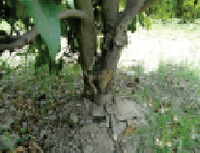 The disease is identified by profuse gumming on the surface of the bark on tree trunk from which gummy substance oozes out. The affected bark turns dark brown and develops longitudinal cracks. The wood tissues are also affected. In severe cases, bark rots and the trees dry because of girdling effect.
The disease is identified by profuse gumming on the surface of the bark on tree trunk from which gummy substance oozes out. The affected bark turns dark brown and develops longitudinal cracks. The wood tissues are also affected. In severe cases, bark rots and the trees dry because of girdling effect.
Transmission
The disease is favoured by rains, heavy to ill drained soils, excessive and flood method of irrigation leading to prolonged contact of trunk and crown with water or moist soil, high water-table, deep planting, low budding and injuries to roots or base of the stem. The primary means by which Phytophthora spp. are spread through citrus orchards is by use of infested nursery stock. The pathogen may be present in soil or infected roots even though disease symptoms are not readily apparent. The fungus like organism is also carried in soil on equipment when vehicles move from infested to non-infested groves or nurseries. Flooding method for irrigation water may also move the pathogen from area to area. Within groves, dispersal by irrigation water occurs especially where furrow or flood irrigation is used. Surface water following heavy rains may carry the pathogen as it drains from the grove.
Management of Citrus Phytophthora
- Trunk Paint: Scrap the affected bark portions of the tree trunk, branches and limbs along with some healthy green bark with the help of sharp Knife or Khurpa. Properly collect and destroy the diseased bark by burning and do not allow it to fall on the ground. Apply the fungicidal paint of Ridomil
- Gold (2 gm in 100 ml Linseed oil) or Trichoderma harzianum @ 100 g/l and paint Linseed oil after five days with the help of painting brush twice in a year during February-March and July-August.
- Soil Drench: Drenching the root zone area of the infected tree with Ridomil Gold (25 g / tree in 10 litres of water) twice in February-March and July-August. Trunk paint can be combined with soil drench for effective disease control.
- Foliar Sprays: Spray application of Aliette 80 WP (2.5 gm/ litre) can be made during April and September for the effective disease control. The spray application will check the lesions on the tree parts as well as regeneration of feeder roots. Aliette spray can be combined with drenching of root zone area with Ridomil Gold.
- Prefer basin method of irrigation or double ring or drip irrigation over flooding method of irrigation
Citrus canker
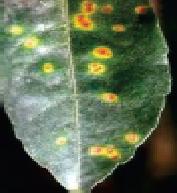
Causal organism : Xanthomonas citri subsp. citri
This disease is endemic to India and occurs in all the citrus growing areas. It is a bacterial disease and is spread with the help of citrus leaf miner. Canker lesions start as pinpoint spots and attain a diameter of 2 - 10 mm. Their eventual size depends mainly on the cultivar and the age of the host tissue at infection. The lesions are initially circular but later may develop irregularly often aggregated at the leaf margin or the leaf tips or in a restricted area of the leaf. Lesion become visible on the underside of leaves about 7 days after infection and on the upper surface soon after. The characteristic symptom of the disease on leaves is the yellow halo that surrounds lesion. Young lessons are raised or pustular, particularly on the lower leaf surface. The pustules later became corky and crateriform, with a raised margin and a sunken centre. Lesions on fruit and stems extend 1-3 mm in depth and are superficially similar to those on leaves.
Scab
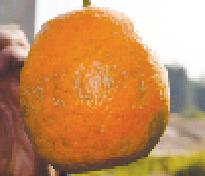
Causal organism : Elsinoe fawcettii
Citrus scab attacks the fruit, leaves and twigs, producing slightly raised, irregular scabby or wart-like outgrowths. The scabs are grey or pinkish at first and become darker with age. They are more common on fruits than leaves. The raised lumps associated with scab can be confused with symptoms caused by citrus canker or with windrub abrasions. Spores of the fungus are readily produced on the surface of scab lesions on young fruits and leaves throughout the year.
Spores of the fungus are spread in the orchard by rain, overhead irrigation and during spraying operations. Dew may also cause the spores to be liberated from the lesions but due to the limited splashing action, there would only be localised dispersal.
Greening disease
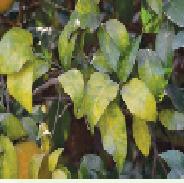
Causal organism : Candidatus - Liberibacter asiaticus
The range and severity of symptoms vary with season, type and extent of infection, age and nutritional status of the trees. Greening infected citrus leaves are generally small, upright and frequently have symptoms with green veins and chlorotic interveinal areas. Diseased leaves also show various types of chlorotic mottling. Leaf mottle is one of the best diagnostic symptoms of greening. In severe cases leaves become almost chlorotic with scattered dark green islands. Symptoms are often seen on part of the canopy or even only in a branch or a twig. Infected fruits are small and mis-shapen, many fall prematurely, while those that remain on the tree do not colour properly, remaining green on the stylar (lower) end and hence the origin of the name 'greening_. Greening disease is transmitted by infected budwoods and in the orchards through citrus psylla. Psylla picks the pathogen in nymphal stage and transmits it when adult.
Management of greening disease:- The management of greening disease involves removal of affected unproductive trees and their replacement by disease-free budded plants developed on improved rootstock through proper indexing programme.
- Regulatory (quarantine) measures should be strengthened to limit movement, sale and use of infected bud wood or nursery stock.
- Strict control of nurseries through registered disease-free certification scheme is essential to prevent the spread of disease.
- Since the disease also spreads through the vector, citrus psylfa, recommended insecticides given in the table should be applied to control the disease spread.
Citrus dieback
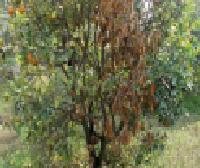
The term 'dieback' means death of plant from top to downwards. Citrus dieback is not a specific disorder but is culmination of several interacting factors such as pathological infections, pest attacks, nutritional disorders, unfavourable environment, faulty cultural practices, poor choice of plant material etc.
The major symptoms include the complete decline of the trees through rotting of the rootlets, girdling of the trunks and dropping and blightening of the leaves. In the early stages the disease appears in the form of light to dark brown on the terminal areas of young growing shoots. The disease starts from the apical part of the shoots and under favourable climatic conditions rapidly spreads downwards up to the base of shoots which show signs of wilting and ultimately die. The infected plants usually blossom heavily and bear small sized flowers and a few fruits which slow brown rotting leading to heavy fruit drop. Rotting of roots takes place and with the increase in the severity of infection, the bark gradually turns black and slips off readily.
Source: NCIPMLast Modified : 2/13/2020
This topic provides information about Pear Dise...
This topic covers information about Passion Fruit ...
This topic covers the Information related to Disea...
This topic provides information about Loquat Dise...
